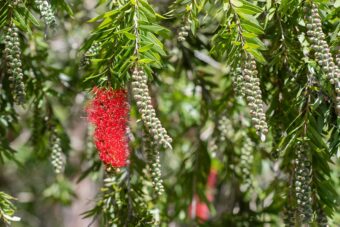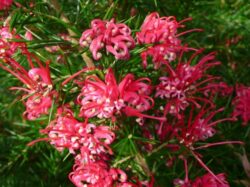In this article, we will discuss how to grow Grevillea, the beautiful flowering shrub, in containers. Grevillea is a large genus of 360 species of evergreen flowering plants that belong to the Proteaceae (the Protea) family. The genus contains mainly shrubs and rarely perennials. The flowers of yellow, pink and red arranged in racemes appear above the leaves at the end of branchlets. The branches have narrow, needle-like green leaves that are arranged alternately along the branches. The flowers are followed by fruits that spilt down one side, releasing one or two seeds.

It has a reputation of not being fully hard as it cannot live through heavy frosts but it is not as delicate as people assume. If you live in a mild area and provide protection from a south-facing wall, then it is well worth the effort.
It is found growing natively in Australia and the flowers really do set it off.
Find out how to grow Grevillea in containers in this article.
GROWING GREVILLEA IN CONTAINERS
Grevillea like their roots to be dry as they detest wet and waterlogged roots. First, choose a container that is large enough to house the plant in and is well balanced and has plenty of drainage holes in them. Add a 2cm layer of gravel at the bottom of the container to improve drainage and on top of this add a good quality multipurpose compost to 5cm below the rim.
Dig a hole at the centre of the container slightly bigger than the root ball it came in its original housing. Place the plant in so that the top of the root ball is at the same level as the top surface of the compost in the container. Backfill with the growing media so that no gaps remain, using more compost if necessary. Firm the plant in and water well.
THE BEST GROWING CONDITIONS
If you want the best for Grevillea then you must grow it in a sheltered, south-facing spot away from cold winds and hard frosts in a sunny place.

As it prefers to be grown on the dry side, it will not need watering frequently once established. Water when 25% of the container feels dry to the touch but when it is establishing water when 5cm below the top of the compost feels dry to the touch, Drainage is very important, so do not overwater at all costs.
As they are used to growing in poor soil, do not fertilize unless the plant is clearly showing signs of lacking nutrients. If this is the case give a feed with a quick-acting fertilizer such as fish, blood and bone or growmore.
Pruning is not necessary and you may spoil the shrub and its shape if you do so. If you want to prune and you deem it necessary, then you can do so after flowering by trimming away unwanted or damaged branches, Pruning may keep the spreading shrub in check.
To propagate you can take semi-ripe cuttings in summer and place them in a pot full of compost. Place the pot in a propagator and you should have a new plant ready for planting next year.
PESTS AND DISEASES
If you grow your Grevillea outdoors throughout the year, then the plant will be relatively pests and diseases free. If you need to move your plant into a greenhouse to overwinter, then it may succumb to red spider mites and mealybugs attack. To prevent this deal with infestations once observed as soon as possible using a suitable systemic insecticide and miticide.
In certain cold areas in the UK, it may need protection from hard frosts by covering with thick horticultural fleece or moving under the protection of a greenhouse.
VARIETIES TO GROW

The most likely variety to find and that can survive a UK winter is Grevillea juniperina, which grows up to 2m tall. A noted variety is ‘Sulphurea’ which has pale yellow flowers in May and June. Each bloom is a narrow tube from which the showy antler protrudes.
Another species that you can find is Grevillea rosmarinifolia (Rosemary Grevillea) which grows taller than the other species mentioned in this article. It has rosemary-like leaves and produces pink and cream-edged crimson blooms from June to August.
The dwarf species that you can find is Grevillea alpine which only grows up to 1.2m high and produces red and cream flowers in April and May.
CONCLUSIONS
In this article, we have discovered how to grow the wonderful flowering shrub of Grevillea in containers. The flowers are special, the leaves are elegant and it is easy to grow and care for. They may be tender in colder climates of the UK, but with climate change, the likelihood of the plant surviving cold winters is very high.
They will look great growing in containers, so why not grow some today
If you have any questions or comments that you would like to make on growing Grevillea in containers, please do so in the comment box below,
Happy Grevillea growing.
